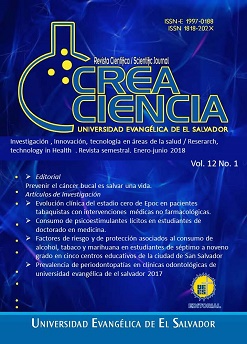Risk and protection factors associated with the consumption of alcohol, tobacco and marijuana in seventh through ninth grade students in five schools in the city of San Salvador
DOI:
https://doi.org/10.5377/creaciencia.v12i1.8069Keywords:
Primary and secondary education centers, El Salvador, risk and protection factorsrisk and protection factors, programs on drug use preventionAbstract
Introduction. The purpose of the study was to determine the existence of risk and protection factors associated with the consumption of alcohol, tobacco and marijuana in seventh through ninth grade students in Educational Centers of the city of San Salvador, El Salvador, Centro America.
Methodology. The study was focused on the prevention of alcohol, tobacco and marijuana consumption because, according to the reviewed background, these are the most consumed drugs in the country.
It was carried out in five study centers, with a descriptive approach and a transversal design, in a non probabilistic sample of 268 students.
Results. The consumption of alcohol, tobacco and marijuana among adolecents continues to be present with prevalences of consumption consistent with those reported by the country for this population in recent years, where the male sex had a higher consumption than female.
We found 33 risk factors associated with the consumption of alcohol, tobacco and marijuana; and only six protection factors.
Conclusion. It is considered that the existence of many risk factors and few protective factors in the environment are o a greater use of drugs ant the low effectiveness of drug prevention programs or strategien in general
Downloads
1141
Downloads
Published
How to Cite
Issue
Section
License
© Crea Ciencia
Declaration of originality and assignment of rights
The article must be sent with a declaration of originality, responsibility and assignment of rights of copy of the manuscript, scanned and signed by the author or by one of the authors when the authorship is collective (designated author), stating that the text has not previously published in printed or electronic format, which will not be presented to any other media before knowing the decision of the journal Crea Ciencia and that, if accepted for publication, the authors transfer the copyrights in all forms and media known. At the end of six months of the publication, the text can be shared in another magazine citing the first version of the article published in Crea Ciencia and recording its number and volume. If the article is not published, the UEES agrees to return the rights enunciated to their authors.

Crea Ciencia articles are published in open access and licensed under a Creative Commons Attribution-NonCommercial 4.0 International License.

